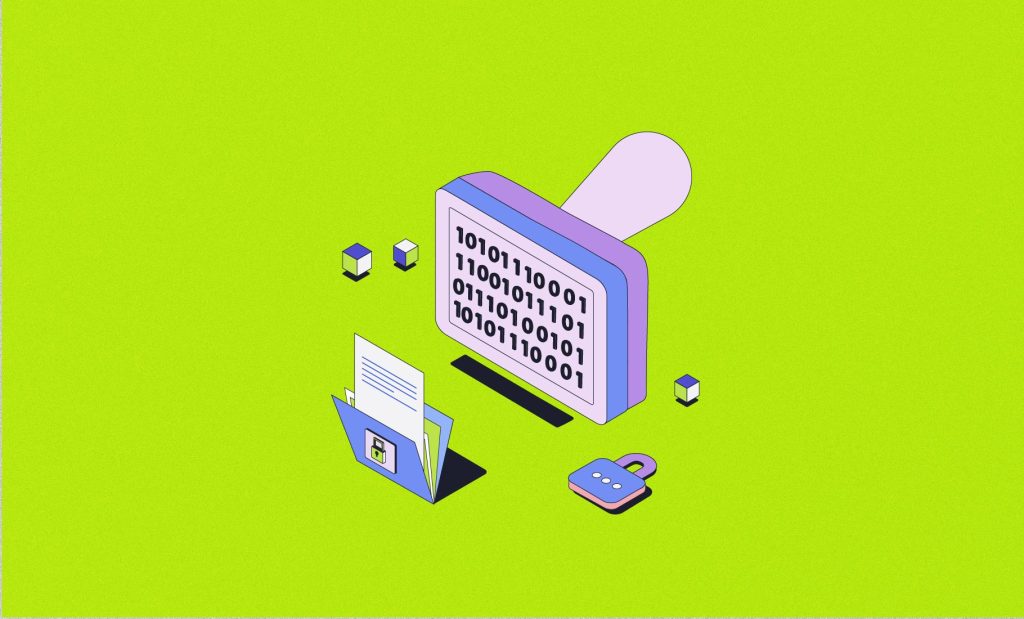Stamps are sometimes used to certify that the information in a document is accurate. Blockchain-based timestamping has a very similar function in the world of crypto. Learn all about them in this article.
What is blockchain-based timestamping?
Blockchain-based timestamping is part of the record-keeping strategy on blockchains. A blockchain, as you may know, is essentially a record/long list of transactional information. There’s no central authority involved. Everything is handled in a decentralized manner by a network of participants. In this system, when a record of the information is created, a timestamp is affixed.
A blockchain-based timestamp is essentially a stamp where the date and time it was affixed are mentioned. It is immutable and tamper-proof.
Timestamps are meant to certify that the document was created at a specific time and has not been modified since. Whenever a new transaction is made, the blockchain adds a new timestamp. This ensures that whenever any subsequent additions happen, the change is reflected on everyone’s ledgers for the sake of transparency.
The fact that it is so hard to get away with manipulating blockchains is why they are so in vogue. And timestamps play a key role in securing this operation.
How does blockchain-based timestamping work?
To sum up what we’ve learned so far, one of the mechanisms used to verify data as part of a decentralized system is blockchain-based timestamps. But what do timestamps look like, and how do they work?
Well, they are essentially a string of characters that helps identify the time when a document was created, or an event occurred.
Here’s how they work:
- While storing a piece of data on a blockchain, it is stamped with a string of characters.
- Each block of the blockchain contains such data on transactions between users. Every block is, therefore, given a unique identifier. This identifier is a combination of the digital signature and the timestamp itself but in encrypted form.
- The hash function provides this identifier by converting an input value to an output value with a fixed number of digits or bits.
What are the benefits of blockchain-based timestamping?
If you’ve understood our explanation above, you probably already know what the benefits of blockchain-based timestamping are. Most of them are related to how they benefit the blockchain as a whole.
Here is a list of some of the benefits that we can think of:
- Security: The timestamps play a key function in ensuring that the blockchain network is virtually impossible to manipulate.
- Transparency: Timestamps can be viewed by pretty much anybody. That, in turn, ensures accountability.
- Decentralization: The role of timestamps in blockchains enables them to stay decentralized and not be controlled by one or a few members of the community.
Applications of blockchain-based timestamping
Blockchain-based timestamping can be put to use in a lot of industries and sectors. Some of them are discussed below:
Insurance
Because there are so many who try to dupe insurance companies, it is important to secure any indisputable records available related to the claimed events, such as property damage or car crashes. Blockchain-based timestamps can help companies with this.
Supply chain management
In today’s world, the supply chain is rife with inconsistent and unreliable information. Simultaneously, consumers are increasingly raising questions about where their purchases were made, how old they are, and so on. With blockchain-based timestamping, the producers can ensure that consumers get the information they need. Transparency and accountability are possible because of this tech.
Management of facilities
Whether it is regular maintenance work or the occasional inspection, blockchain-based timestamps can go a long way in maintaining daily records. The fact that they cannot be tampered with proves to be invaluable in times of crisis when people have to be held accountable.
Intellectual property rights
When something is created, it is important to preserve information relating to its date of creation and keep a record of all subsequent modifications. Doing so secures the creator’s intellectual property rights. Blockchain-based timestamping allows creators and artists to mark their work and retain leverage when negotiating deals, copyrights, or licensing agreements. The immutability of timestamps is key to this.
Blockchains are not just about crypto. They are a technical revolution that is set to drive many sorts of decentralization efforts. And blockchain-based timestamps are at the heart of it all.
FAQs
Why is timestamping important in cryptocurrency transactions?
Timestamping in cryptocurrency transactions is crucial for establishing the order of transactions, preventing double spending, and ensuring the integrity of the blockchain ledger. It enhances transparency and trust in the system.
How does blockchain technology ensure accurate timestamps?
Blockchain technology maintains accurate timestamps through network synchronization, consensus among nodes, and immutable recording, enhancing transaction order, security, and trust in decentralized systems.
What are the advantages of blockchain timestamping in crypto?
Blockchain timestamping benefits: Immutability, transparency, trust, legal proofs, and data integrity verification, enhancing security and reliability in cryptocurrency transactions and document validation.
Can blockchain-based timestamping prevent transaction fraud?
Blockchain-based timestamping can help prevent transaction fraud by providing an immutable and transparent record of transactions. However, it doesn’t prevent all types of fraud, as it primarily focuses on ensuring the accuracy and order of transactions. Other security measures, such as encryption and authentication, are also necessary to address different aspects of transaction fraud.








